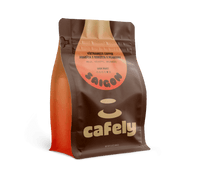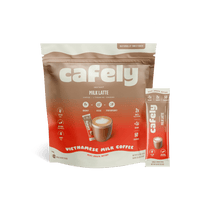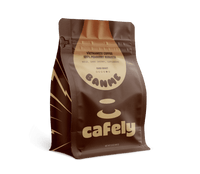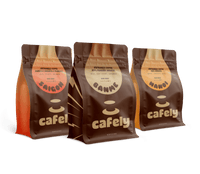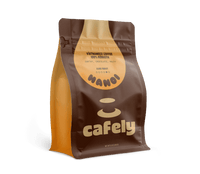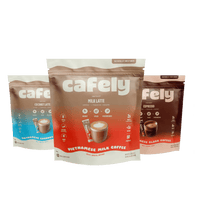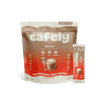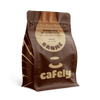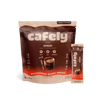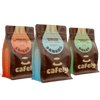The cortadito is a bold, rich, sweet, and creamy coffee from Cuba. This coffee has an intriguing history and is a large part of Cuban coffee culture.
Learn about the cortadito coffee, its origins, how to make the brew, and other Cuban coffees in this guide…
What is Cortadito Coffee?
The cortadito is a type of Cuban coffee that's made with a strong shot (similar to espresso) that's made with a moka pot. It has Spanish roots and is similar to how the cortado coffee is made, which means “cut” — referring to how an espresso is cut with a small amount of milk. The cortadito contains a 1:1 ratio of coffee and steamed milk and a rich, sweet, creamy foam called espuma.
The cortadito is typically produced from 100% arabica coffee or a blend of arabica and robusta. Blends are popular for their dark, bold taste and higher caffeine content.
Espuma is the defining characteristic of most Cuban coffees, and the cortadito is no different. Espuma is made by rapidly whipping the first few drops of moka pot coffee with white granulated sugar. This creates a dense, velvety foam that's intensely sweet. The espuma sits on top of the cortado and forms a sort of "sweet crema.”
The cortadito is a rich and flavorful Cuban coffee drink. Similar to a coffee latte, it's creamy, velvety, and sweet.
What Does Cortadito Coffee Taste Like?
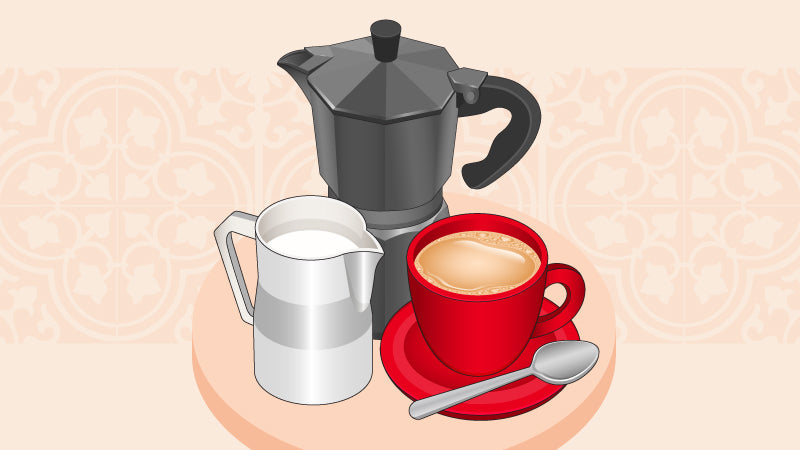
Cortadito has a bold, dark, nutty flavor from the strong moka coffee and a rich, creamy flavor from the steamed milk. It has a light, velvety texture similar to a latte and a sweet, frothy foam on top.
The Origins of the Cortadito Coffee
The cortadito can be traced back to Spain. A similar brew called the cortado was introduced to Cuba by Spanish immigrants. These migrants introduced their coffee traditions to Cuba sometime during the late 19th or early 20th century.
Over time, the cortado evolved into the Cuban cortadito we know today. By combining the sweet espuma with steamed milk and Moka pot coffee, Cubans altered the original Spanish cortado to create their own brew, which is now a large part of Cuban coffee culture.
The cortadito became a big part of life during the early 20th century, and it still is today. It's often enjoyed as a social routine or an after-dinner beverage.
The cortadito is more than just a coffee in Cuban culture — it symbolizes hospitality, conversation, and community. Alongside other Cuban coffees such as the colada and café con leche, the cortadito is usually shared with friends and family rather than a “lonely” morning brew to boost energy.
How Does Cortadito Compare to Other Cuban Coffees?

The cortadito is part of a foursome of traditional Cuban coffees. All of these brews are made using a moka pot or, in some cafes, an espresso machine. They're all similar but have a few distinct differences that make them unique.
Here's how cortadito compares to other types of Cuban coffee:
1. Cafecito

The cafecito is often referred to as a Cuban espresso. It’s the simplest and most traditional of the Cuban brews. The cafecito is traditionally made using a moka pot and is served in a small coffee mug.
This brew is served black with a sweet and frothy espuma on top. The bold, dark, slightly bitter coffee is complemented by the rich, sweet foam.
2. Colada

The colada is the same as a cafecito. However, a larger volume of coffee is brewed. The colada comes in a large coffee cup with six thimble-sized styrofoam demitasse cups with it.
In Cuban coffee culture, the colada is ordered to be shared with friends. It's a social ritual, and the small cup sizes allow several servings to be drunk over a lunch break, evening "catch-up," or social gathering.
3. Cortadito

The cortadito is made by combining strong, moka pot coffee with steamed milk and espuma. It’s served in a small coffee cup (around 150 mL) with a coffee-to-milk ratio of 1:1.
The cortadito balances the strong flavors of a cafecito with the creaminess of milk and the sweetness and unique texture of espuma.
In Cuban coffee culture, it’s often consumed as an after-dinner “digestif” in place of alcohol.
4. Café Con Leche

The Café con leche is similar to a cortadito. It's made using a strong cafecito shot, but instead of a 1:1 coffee-to-milk ratio, the café con leche uses a 1:2 coffee-to-milk ratio. However, it's not always consumed at this ratio…
The café con leche is traditionally served in two mugs — one with the steamed milk and one with the coffee. This allows the drinker to mix the coffee and milk according to their taste. Café con leche is usually served unsweetened, however some regions serve it with espuma.
The café con leche is a traditional Cuban breakfast coffee. It’s traditionally served alongside a slice of toasted bread with butter.
What Do You Need to Make a Cortadito?
You don't need much to make a cortadito. However, you'll need a moka pot or espresso machine and some way to steam or froth milk.
Here's what you need to make cortadito coffee:
Equipment
- Moka Pot — These stovetop brewers are available in a range of sizes from one serving up to 12.
- Coffee Grinder — The best cortadito coffee is made using freshly ground coffee. To produce the fine grind needed for this brew, use a burr grinder.
- Gas Stove — Use a gas stovetop if possible (this provides the best control for the moka pot). If not, an electric hob will work.
- Small Mixing Bowl — You'll need a small mixing bowl to create the espuma (foam).
- Spoon — Traditionally, a small spoon is used to create the espuma. However, you may find it easier with a fine whisk until you develop the right technique.
- Milk Steamer or Frother — You'll need a way to warm and froth your milk. You can do this with a steam wand (found on some coffee machines) or you can heat the milk in a small stovetop pan and whip it using a milk frother or fine whisk.
- Small Coffee Cup — A small coffee cup (150–180 mL) is enough for a cortadito. You can also use a small heat-proof glass.
Ingredients
- High-Quality Coffee — Opt for a high-quality whole-bean arabica coffee for making cortadito coffee.
- Water — Use fresh, filtered water for the cleanest brew.
- Sugar — You'll need white granulated sugar to create the espuma needed for a cortadito.
- Whole Milk — Use whole milk for a traditional cortadito. If you're vegan, opt for a plant-based milk that steams well.
Coffee Recommendations
You should use freshly roasted, freshly ground high-quality coffee for making cortadito coffee. Using whole-bean coffee and grinding it finely just before brewing will produce a cup with the most complex, decadent flavor profile.
To make an authentic cortadito, you should use DaLat Coffee (which contains 100% organic, single origin Arabica), or a robusta and arabica blend, such as Saigon OG. Blends produce a slightly darker, bolder brew with a higher caffeine content.
How to Make Cortadito Coffee (Step-by-Step Guide)
The cortadito is relatively simple to make — it's essentially a latte made with moka pot coffee (or espresso in some cafes) and steamed milk. The major difference is the addition of espuma — the sweet foam that sits on top of the brew.
Here's how to make authentic cortadito coffee:
1. Grind Your Coffee

First, you'll need to measure and grind your coffee. Use a burr grinder to produce a consistently fine grind size — similar in texture to sand powdered sugar. You'll need enough ground coffee to fill the filter basket on your moka pot.
Use the table below to work out how much coffee and water you need:
|
Moka Pot Capacity |
Coffee Shots Produced |
Coffee (Grams) |
Water (mL) |
|
1-Cup Moka Pot (60 mL) |
1 shot |
6 grams |
65 mL |
|
3-Cup Moka Pot (200 mL) |
3 shots |
20 grams |
220 mL |
|
6-Cup Moka Pot (300 mL) |
5–6 shots |
30 grams |
330 mL |
|
9-Cup Moka Pot (600 mL) |
8–10 shots |
60 grams |
660 mL |
|
12-Cup Moka Pot (780 mL) |
10–12 shots |
80 grams |
880 mL |
2. Prepare Your Moka Pot

Fill the bottom chamber of your moka pot with cold, fresh, filtered water. Next, fill the filter basket with your ground coffee and tamp it lightly.
Assemble the moka pot by placing the filter basket into the bottom chamber before screwing the collection chamber on top.
3. Begin the Brewing Process

Place the moka pot on your stove and turn the heat to medium. Wait for the pot to make a distinct gurgling noise — this indicates that the pot has begun brewing. Lower the heat on the stove to its lowest setting.
4. Make the Espuma

In a bowl add one to two tablespoons of white granulated sugar (per serving of coffee planned).
Take the first drips of coffee that come through the spout of the moka pot using a small spoon. Pour the small amount of freshly brewed coffee into the bowl until the sugar is saturated but not soaked.
Whisk the sugar and coffee mixture rapidly using your spoon or a fine whisk until a smooth, velvety, sticky foam has been produced.
5. Finish the Brew

Wait for your moka pot to finish brewing. Once the pot begins spluttering and sounds “hollow,” the process is complete.
Once brewed, turn off the heat.
6. Steam the Milk
Using a steam wand on an espresso machine (or another brewer with a steamer), heat and froth the milk until it's light and velvety. Cortadito contains a 1:1 ratio of milk and coffee — if you're using a single 60 mL moka shot, you'll need 60 mL of steamed milk.
If you don't have a way to steam the milk, heat it in a small stovetop pan and froth it using a milk frother or fine whisk.
7. Assemble the Cortadito

Pour your coffee into a small coffee cup. Then, add the steamed milk and stir lightly. Gently spoon the espuma on top of the brew and serve.
Enjoy your cortadito while warm.
FAQs: Cortadito Coffee
Want to learn more about cortado coffee and other Cuban brews?
Read through the answers to the FAQs below:
1. What’s the Best Coffee for Cuban Coffee?
The best coffee for Cuban coffee such as the cortadito is arabica. Opt for a high-quality 100% arabica coffee or an arabica-rich blend. It’s best to buy whole-bean coffee and grind it just before brewing — this will produce the most complex, balanced cup.
2. How Much Caffeine in a Cortadito Coffee?
The amount of caffeine in a cortadito coffee varies depending on the type of beans used, the coffee-to-water ratio, and the volume of coffee. The average cortadito can contain anywhere from 75 to 150 mg per serving.
3. What is Espuma?
Espuma is a delicate, sweet foam that’s made by whipping the first drips of moka pot or espresso coffee with white granulated sugar. This foam is served on top of a cortadito and other Cuban coffees such as the cafecito
4. What’s the Best Sugar for Cortadito?

The best sugar for making the espuma that sits on top of a cortadito is refined white sugar. Although demerara or piloncillo provide more complex, caramelized flavors, plain white sugar produces a more velvety foam.
5. Can You Make a Cortadito Without a Moka Pot?
Traditionally, the cortadito and other Cuban coffee are made using a moka pot. However, you can make the same brews using an espresso machine. Immersion brewing using French press and other low-pressure styles aren’t suitable for cortadito.
6. What’s the Best Grind Size for Cortadito Coffee?
When making a cortadito using a moka pot or espresso machine, you should use a fine grind — similar in consistency to powdered sugar. It’s important to produce a consistent, fine grind to produce an even extraction.
7. What is Cuban Coffee?
Cuban coffee isn’t one “strict” type of coffee. It’s made from 100% arabica coffee or (usually) a blend of arabica and robusta. Cuban coffee is dark, bold, and strong. It’s typically brewed in a moka pot, which produces an espresso-like brew. It’s also (usually) topped with espuma — a sweet sugar foam.
There are four main types of Cuban coffee — the cafecito, cortadito, colada, and café con leche.
8. What’s the Difference Between a Cortadito and a Latte?
The cortadito and the latte are both milk-based coffees that combine strong espresso coffee and steamed milk. However, the cortadito is topped with espuma (sugar foam), and the latte is made with more steamed milk.
9. What Ingredients Do You Need to Make a Cortadito?
You need high-quality coffee, steamed milk, and white granulated sugar to make a cortadito. You also need a moka pot, a coffee grinder, a coffee measure, a coffee mug, and a mixing bowl.
10. What’s the Strongest Cuban Coffee?
The strongest type of Cuban coffee is the “colada.” This brew is essentially a larger version of the popular cafecito, but it’s slightly more concentrated and served in small demitasse-sized styrofoam cups.
